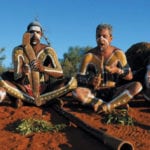 The Arts
The Arts  The Arts
The Arts  Crime
Crime 10 Fascinating Facts about Rikers Island
 Pop Culture
Pop Culture 10 Things You Might Not Know about Dracula
 Weird Stuff
Weird Stuff 10 Everyday Activities That Were Once Considered Illegal
 History
History Ten of History’s Hidden Secrets: Stories 99% Don’t Know About
 Movies and TV
Movies and TV 10 Actors Who Infamously Stormed Off Set While Filming
 Food
Food 10 Foods That Have Alleged Occult Powers
 Sport
Sport 10 Lesser-Known Multi-Sport Alternatives to the Olympics
 Humans
Humans 10 Real Life Versions of Famous Superheroes
 Gaming
Gaming 10 Overused Game Villains
 The Arts
The Arts 10 Masterpieces Plucked from the Artist’s Subconscious
 Crime
Crime 10 Fascinating Facts about Rikers Island
 Pop Culture
Pop Culture 10 Things You Might Not Know about Dracula
Who's Behind Listverse?

Jamie Frater
Head Editor
Jamie founded Listverse due to an insatiable desire to share fascinating, obscure, and bizarre facts. He has been a guest speaker on numerous national radio and television stations and is a five time published author.
More About Us Weird Stuff
Weird Stuff 10 Everyday Activities That Were Once Considered Illegal
 History
History Ten of History’s Hidden Secrets: Stories 99% Don’t Know About
 Movies and TV
Movies and TV 10 Actors Who Infamously Stormed Off Set While Filming
 Food
Food 10 Foods That Have Alleged Occult Powers
 Sport
Sport 10 Lesser-Known Multi-Sport Alternatives to the Olympics
 Humans
Humans 10 Real Life Versions of Famous Superheroes
 Gaming
Gaming 10 Overused Game Villains
Top 10 Real Superpowers You Can Learn
Superheroes are the objects of fancy and admiration for millions the world over. They right wrongs, protect the weak, and rescue society from innumerable forms of injustice and peril. There’s only one glaring problem: They aren’t real. The incredible feats performed by these stalwart defenders are made possible by uncanny powers that, sadly, are fictional.
Or are they?
SEE ALSO: 10 Real-Life People With Real Superpowers
What if I told you that natural superpowers exist sealed away in our bodies, only waiting for the proper training to awaken them? Well, as unbelievable as this may sound, it is actually true. So if you’re ready to transcend your fragile human shell and become the superhero you’ve always dreamed of being, here’s a list of ten abilities that you can unlock to become a superhuman!
10 Superhuman Strength
Strength is a much more complex concept than many realize. It is not just about how much muscle we have, but even more so how well we use it. One need not be a bodybuilder to have super strength, as proven by grand master strongman and pound-for-pound strongest man in the world Dennis Rogers. Rogers has performed many incredible feats of strength, including preventing airplanes from taking off and holding back four Harley-Davidson motorcycles at once. These are impressive feats for any strongman but are especially incredible considering that Dennis Rogers is only 168 centimeters tall (5’6″) and 76 kilograms (168 lb). And he’s in his fifties. So how does he do it? The answer is plyometrics.
The goal of plyometrics is to access more of the dormant strength in our muscles by partially bypassing a natural function of the nervous system called the inhibition reflex. The golgi tendon organ (GTO)—present in every muscle—sends nerve impulses to our spinal cords every time we use a muscle. The spinal cord then responds with an inhibition reflex, which limits the amount of power your muscle can use. This process exists because human muscles are capable of creating a higher degree of force than they and other structural elements of the body can withstand. If not for this, reflex muscles would tear themselves from tension, and people would strike things with more force than their bones and tendons could handle without breaking. The GTO however, does not suppress your power only at the edge of damage. Through training with quick, explosive exercises, plyometrics gives us the ability to force out more power more rapidly, before the inhibition reflex occurs.[1]
The intent of plyometrics is to train your muscles to release more power more rapidly from the muscle that you have, with the goal of generating as much power as possible before the inhibition reflex occurs. To achieve this, plyometrics is based on quick, explosive exercises, which focus on generating immediate force and developing your fast-twitch muscle fibers. In addition to training explosive burst techniques and exercises, an important part of developing fast-twitch muscle is exhausting slow-twitch muscles in other, more extended stamina-oriented workouts, at which point fast-twitch muscle fibers take over and begin to develop.
Plyometrics are wonderful, but muscle is still the source of that strength, so we still need some. There is a difference between how much muscle you have and how strong that muscle is. Both are equally important, and both are trained differently. Muscle growth, or hypertrophy, is best trained through pushing muscles to the point of exhaustion through high reps and consecutive workouts for the same muscle groups. Strength, on the other hand, is developed with lower reps of more weight and reasonable rest time in between.
9 Lightning Speed
You’re probably thinking, “Sure, there are some fast people out there, but there’s a difference between being really fast and ‘superhuman speed.’ ” However, anyone lucky enough to have had the illustrious pleasure of working with the late, great Bruce Lee would likely beg to differ. In order for Lee’s movements to be reasonably visible on film, they had to be slowed down two-fold. First, he would intentionally move slower so that the camera could capture his movements, and then afterward, the film would be slowed so that the eyes of the viewer could follow what was happening. If these measures weren’t taken, it would appear that the villains surrounding him would simply fall over for no reason without any visible cause.[2] If speed beyond the comprehension of the human eye isn’t fast enough in your opinion to be considered superhuman, then you’re certainly a tough one to impress.
Fighting fast is one thing, but if we’re going to talk about real super speed, we need to take running and other types of movement into account as well. Luckily, this traces back to the same core concept, which is fast-twitch muscle fiber. This is the same fast-twitch muscle fiber discussed in the previous installment regarding super strength and is trained largely with the same type of concepts: plyometrics and explosiveness, as well as focusing these types of training on the muscle groups necessary for the abilities you want to achieve.
Fast movement, however, is not the only element of lightning speed. In order to be capable of utilizing this speed effectively, one must also have super reaction time. Without this, all the speed in the world is meaningless. The best way to train reaction time is through reaction-oriented activities, such as the hand-slap game and speed bag training, as well as through visual athletic training, such as robo-pong, focus loop, and brock string exercises.
8 Incredible Agility
So far, we’ve explored a few powers that will help you knock around the baddies. To do so, you’ll need to get there in time to save . . . whoever it is you’re saving. Super speed will help you with that, but you’ll need to round it out with the super agility to get past obstacles that most people can’t, and quick!
Parkour is just what you need. As stated by founder David Belle: “Parkour is a method of training which allows us to overcome obstacles, both in the urban and natural environments.” Likely the most notable paths for parkour users (traceurs) is across rooftops, as shown in the Rush Hour BBC promo, which was the introduction of parkour to the mainstream.[3] Being agile enough to climb and jump and run across daunting obstacles may not sound like much of a superpower, but just watch any of the wealth of homemade parkour videos out there, and you’ll be shocked by the incredible things already being done by many across the world!
Founded in 1990, parkour is a relatively new concept but has taken the world by storm and has many training schools around the world. This is important because parkour, when not learned under professional guidance, can be extremely dangerous for obvious reasons (including falling from the rooftops you’re jumping across).
7 Extreme Flexibility

Extreme flexibility is one of the most well-known of all real superpowers. Contortionists have been a staple of the performance world since as far back as ancient Egypt and possibly beyond. A master of this art is Daniel Browning Smith, also known as “Rubberboy.” Recognized by Guinness World Records as the world’s most flexible man, he is known for squeezing himself through unstrung tennis rackets, rotating his torso 180 degrees, bending in half backwards from a laying position, and, of course, squeezing into tiny boxes, not to mention all of the other skills commonly associated with the art.
Jujutsu and its cousins, Brazilian jiu-jitsu and judo, as well as other forms of technical grappling are highly effective and popular martial arts. These styles of ground combatives utilize submission, choking, limb-breaking, and various other types of grappling techniques, and flexibility is essential. Flexibility also increases the quality of many striking techniques, and that’s not just for flashy moves and high kicks. Speed and range of motion in power-generating body parts, like the hips, lead to more powerful strikes.
Healing and recovery are also dramatically increased with superior flexibility, as it decreases stress on joints and reduces pain, making us more resilient and getting us back into action more quickly after a particularly strenuous battle or damaging injury.
Training flexibility is largely based on engaging in all types of stretching regularly and frequently. Dynamic stretching involves gradually increasing reach, movement speed, or both, when moving parts of your body. Ballistic stretching is less controlled and relies on using momentum to push a body part beyond its usual range. Static stretching involves holding a muscle stretched at its farthest point and has two subtypes: static-passive, which is holding the stretched muscle with some external force, and static-active, which means using only the muscles to hold the stretch. Another type, isometric stretching, involves tensing of the stretched muscles, such as if a partner is holding your leg high while you try to push it down. (This is but one of many examples of isometric stretching.)
All types of stretching are necessary for extreme flexibility, but isometric stretching is the best for developing strength and range of motion for athletics and contortion, so using it as a primary focus in your training is key for this kind of ability.[4]
6 Ultra Fortitude
For a truly superhuman body, fortitude and toughness are of primary importance, as superheroes are faced with constant threat to their bodies. Methods of body conditioning have been used for many years in the world of martial arts, one of the most common concepts being bone mineralization, also called calcification. Bones are primarily comprised of calcium, and the amount and density of calcium in those bones determines their size and structural strength. Resistance training in one’s workout routine is a simple and safe way to achieve mineralization. It is even suggested to help the elderly maintain their health.[5]
When the body detects that its bones are absorbing large amounts of force, a natural mechanism sends more calcium into the bones, increasing their size, density, and weight, thus adding to the structural integrity of their owner’s body and, in some ways, even striking power. This concept is called Wolff’s law. Many types of martial artists through history have utilized this concept by striking objects repeatedly to cause a calcifying reaction in the bones, including the legendary Shaolin monks.
Davis’s law is a concept similar to Wolff’s law, the difference being that where Wolff’s law concerns bones, Davis’s law concerns soft tissue. The body’s capacity to respond to stress is not limited to bones, and the soft tissues of the body can be trained to harden through stress as well, resulting in more resilient muscles and organs, as well as a boost to pain resistance, which is important, as well.
Having a body that can structurally survive as much punishment as possible is great, but how much pain and suffering the hero can endure before giving in to a villain or extraordinarily arduous task is another thing and also extremely important. Pain has two primary concepts behind it: threshold and tolerance. Threshold represents how much stimulus is required for something to feel “painful,” and tolerance represents how much of that pain one can physically and psychologically endure. Unfortunately, there seems to be no way of increasing one’s pain threshold, but tolerance can be trained, and to a remarkable degree.
A good place to look for this is once again is to the Shaolin. These incredible warrior monks perform superhuman feats of pain regulation, such as lying on spears and having large stones smashed on their stomachs. How do they do it? Meditation. By controlling their minds, the Shaolin can actually distract themselves from and even reduce pain, making it nearly, if not totally, irrelevant. If that’s not superhuman pain resistance, than what is?
5 Surviving Extreme Temperatures

In 2007, Wim Hof set a world record when he immersed himself in ice for 72 minutes in nothing but shorts and boots, and this isn’t even his most incredible feat. He has also climbed Mount Everest, again, in nothing but shorts and boots (he was only stopped from reaching the summit by a foot injury), and run a marathon in the desert without water.
Wim Hof, or “The Iceman,” as he is known, manages such things with a heightened connection to and control of his body. This may sound like something that is likely a trick or hoax, but Hof has always done his work under scrutiny by scientists and journalists, all of whom verify his claims.[6] Though he has been observed by the scientific community closely enough to prove his legitimacy, exactly how his methods work remains a mystery to science.
So how is it possible to train something that can’t be identified? And how is it that we can be sure that Wim Hof isn’t a one-off freak of nature? Because he teaches people. That’s right, you can take lessons from the man directly, and even if traveling to Europe to train with the man is too much, there are training videos on his website!
4 Enhanced Immunity

Another accomplishment of the Wim Hof method is increasing your immunity! This was proven when Wim Hof was documented resisting that symptoms of an endotoxin introduced in a medical laboratory. The scientists were astonished by what they witnessed but doubted that anyone else could replicate Hof’s feat. To test this, 12 students of Hof’s were brought in, and all of them resisted the toxin, just like Hof!
The Wim Hof method may be incredibly impressive, but it’s not a cure-all, and as dangerous as it may be, for many potential contaminants, the only way to protect ourselves is to expose ourselves. Tolerance to poisons and other toxins is most commonly achieved by consuming or injecting a very small, survivable amount into one’s body at a steadily increasing rate as the body’s natural defensive reactions continuously toughen the body’s immunity to said toxin. This term for this is “mithridatism.”[7]
Vaccines are a similar concept, created as “imitations” of a disease that cause no illness and are intended to provoke a response from the immune system, which then produces antibodies and T-lymphocytes which protect us against the illness in question.
3 Apnea Diving

Apnea diving, or freediving, is so popular and well-known that it is not only a superhuman ability but also a sport! AIDA International Freediving is a democratic, international organization that sets rules and regulations for safety in the sport, in addition to maintaining world records and organizing events all over the planet. Although scientists believed for years that humans could only survive underwater for a few minutes tops and at depths no deeper than 50 meters (164 ft), some of the world records in this sport include dives to depths well over 200 meters (656 ft), with some lasting over 11 minutes on a single breath![8]
This is possible because of an evolutionary adaptation called the “diving reflex.” The action of this reflex is to shut down and/or slow physiological functions that use oxygen, thus allowing our bodies to operate on less oxygen for a longer period of time. Blood shift is another phenomenon also necessary in freediving. This function allows the lungs to fill with plasma, preventing their collapse from pressure.
Though recognized as a sport worldwide, freediving is still extremely dangerous to the ill-prepared. Improper preparation and faulty or mismanaged equipment have caused numerous deaths in the sport. Because of this, it is important to seek proper instruction.
2 Echolocation

Many have heard about how some blind people can use echolocation to navigate their surroundings, but a 2013 study from Ludwig Maximilian University of Munich biologists shows that sighted people can learn this skill, as well! It turns out that the ability to echolocate is a talent that lies dormant within everyone. This is because our brains have learned to shut out echoes so that we can focus more effectively on the primary source of a sound, rather than having the constant distraction of echoes of everything around us. The trick to learning echolocation is to learn to “tune in” to the echoes that already exist in the world.
The LMU experiment consisted of sighted people outfitted with a headset that contained earphones and a microphone. The participants made a vocalization, and the appropriate echo in relation to objects and spaces in the room was created through the earphones. This test allowed sighted people, over a few weeks of training, to learn to extrapolate information regarding shape, size, and distance from the given echo.[9]
1 Mind Control

Controlling others like puppets may not be realistic, but implanting thoughts and altering the way people think very much is. The human subconscious is frighteningly vulnerable, and controlling minds through planted suggestion is more accessible a skill than many would presume. This is why the reader should learn about this, not only to use if need be but also to defend against it should one come across a user of these techniques.
The essential element of this process is to go after the subconscious mind while the conscious mind is otherwise focused, and here are the five most common techniques: Covert hypnosis entails convincing someone that your thoughts are their own through suggestive, focused conversation. When one engages in pattern interruption, they create a brief hypnotic moment by forcing someone’s concentration through an abnormal behavior (such as placing a hand on someone’s chest in place of shaking their hand in a greeting—the moment it takes them to analyze the situation will cause a brief hypnotic state). The Zeingarnik effect is concentration that naturally occurs in people toward incomplete tasks. This can be achieved by telling someone an incomplete story, otherwise causing them to focus on an incomplete task. During this period of distracted focus, they are highly suggestible. Another method is to use ambiguous phrases or comments that require someone’s focus to analyze, causing a brief period of high suggestibility. Finally, there are hypnotic keywords, subconscious-evoking phrases like “imagine if . . . ” that can cause a rise in accessibility to someone’s subconscious. This technique is a bit vague and weaker but still very commonly used.
Controlling others is not, however, the only use of these skills. One of the most important uses—and the reason this item was saved for last on the list—is that these tricks can be used to help develop ourselves. The reader may be overwhelmed by the sheer apparent degree of effort needed to attain the things listed here, but by getting control of oneself using techniques such as self-hypnosis, it is remarkable what challenges the average person can overcome and what accomplishments they are able to achieve.
Using mind control on yourself is largely made up of neurolinguitsic programming (NLP), which in this context, is largely made up of two techniques: The flash technique is an NLP exercise in which one visualizes an image associated with a negative feeling in a given circumstance brightly and vividly. The person then implants in that imagined image another, much smaller gray scale image of their preferred feeling in that circumstance. Gradually, the preferred imagine grows to take over the negative image, with the color draining from the negative image to the preferred image. This process is repeated over and over until psychologically successful. Anchoring is associating an internal response with an external or internal stimulus in order to reaccess the internal response (similar to how seeing something nostalgic will remind you of how you felt when you first saw it). This effect can be manually created by choosing a simple, self-creatable stimulus—such as making a hand gesture or touching yourself in a certain way and repeating that action when you want to associate the anchored feeling to a given task at hand.[10]
Though only a few techniques in each category have been listed here, there are actually a great number of others that can be used to achieve the same forms of control.
So there you have it: ten learnable superpowers ripe for practice. Clearly, in the brevity of this listicle, the complete process of learning such wondrous things is not expressible, but all of the items are out there and ready to be trained. All that’s left now is to reach out, grab for destiny, and, of course, always use your powers for good.
Excelsior!
Jason Karras writes, therefore he is.
Read about more amazing human abilities on 10 Real-Life People With Real Superpowers and 10 Tribes With Superpowers You Wish You Had.








